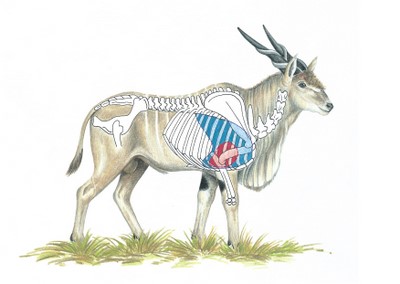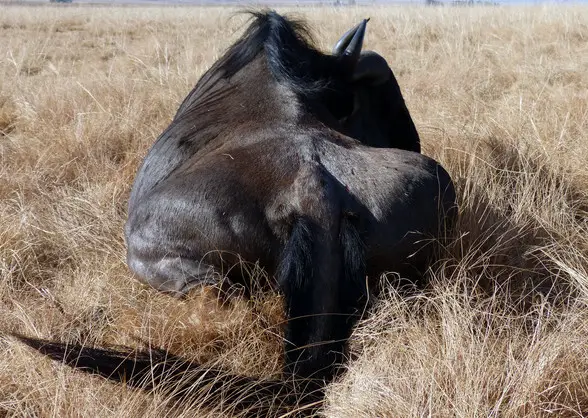


The Mythology of the Correct Big Game Cartridge, the Mystery of Thin-Skinned Game, and Nutty Rating Systems
It has been going on since the origin of hunting: the clumsy co-mingling of scientific terms applied to baseless speculation. We know that a bullet cannot knock an animal down, it would take a new branch of physics for that to be possible. Yet, the odd notion of “knock-down” persists.We have an odd collection of various game formulas, and redundant references to “thin-skinned game.” Yet, virtually all big game animals commonly hunted do indeed have thin skin. Nor is skin in any way a vital organ from a terminal ballistics standpoint. To be sure, there are animals with thick skin. The white rhinoceros has skin 18 – 20 mm in the thinnest area, 45mm or more at the shoulder. While there is legal rhino hunting, buying a new house tends to be a better investment for most folks. Sadly for the rhino, it grows a large protuberance on his nose made of fingernail material some will pay large some of money for, and has suffered heavy poaching as a result. For those clinging to the notion of the power of eating rhino horn, ingestion of their own toenail clippings apparently would give similar if not identical results.
ANATOMY AND PHYSIOLOGY
Above, the world's largest antelope, the Eland.
Nevertheless, the basic anatomy and physiology of deer family animals (deer, elk, moose), antelope (kudu, hartebeest, waterbuck, gemsbok, wildebeest, eland), horse (zebra), and cattle (American and European Bison, Yak, African Buffalo) is not dramatically divergent. And, a pig is a pig and a bear is a bear.
There are significant differences in mass, strength, and the accompanying heavy bones and thick muscle associated with larger animals, of course, but that's hardly any scientific basis for throwing different CXP numbers (or the formula of the week) at different names of animals that are biologically quite similar. No one would expect good results from a gut shot on an Impala, so poor shot placement on the heaviest antelope, the Eland, which weighs from 900 to 2000 pounds or so cannot be expected to yield positive results.
There is no basis for considering the common Eland to be greatly different, as a game animal, than a 900 - 1200 lb. Newfoundland moose, or a larger example of the Giant Eland to be wildly divergent from a 1400 - 1600 lb. Alaskan or Yukon moose. Nor would the majestic Waterbuck or Kudu be wildly different, from a hunting perpective, from Rocky Mountain or the heavier Roosevelt elk.
Craig Boddington conducted two surveys of licensed African professional hunters, one in 1989 and the second in 2007. According to Craig, “In 1989 the 7mm magnums were extremely popular both as a professional hunter’s personal choice and as a recommendation to a client. The .30-06 also did well, but there was little support for the .270.” In 2007 this changed dramatically as there was little support for 7mm magnums, the old 7×57 was much stronger for “light plains game” (whatever that means) but the winner in this category was the .270 Winchester. This suggests that some hunters, including professional hunters, are just as bewilderingly fickle as ever.
IF I AM A .30-06, WHAT AM I?
That some up the problems with assuming a cartridge means something. A .30-06 throws what bullet weight at what velocity, exactly? What is the bullet design in addition to that, and how long is the barrel? As for further variables, we have the age, sex, weight, and health of the animal to consider, as well as the range the animal is being taken at.
One common .30-06 load is a 150 grain bullet that has about 2081 fps residual velocity at 300 yards, is Federal load #3006A. Just what is the difference supposed to be, to an animal, versus a .30-30 Winchester 150 grain load used at 100 yards (load #F3030FS1) that has 2086 fps velocity? The differences become weaker yet if, for example, you are using a .308 Winchester out of a compact rifle that has a 16-1/2 inch barrel length. You might well be throwing your 150 grain round at 2550 fps or so muzzle velocity instead of the 2910 fps with the .30-06 150 grain round, out of a 24 inch barrel.
OPTIMAL GAME WEIGHT FORMULA (and other nonsense)
Once you've created a proper wound track through the entire width of the animal, as was the case with this Blue Wildebeest shown above, there is little else that can be hoped for. Penetration beyond this level is superfluous.
One of the better attempts for the calculating of cartridges is the Edward A. Matunas “Optimal Game Weight Formula.” It withstands no close scrutiny, as bullet construction, sectional density, nose design of the bullet, and caliber are ignored and not represented in the formula. Game weight itself is no exact barometer of what you need in terminal performance. For example, an animal with a large, heavy rump and heavy legs to support it may well be heavy.
Yet, rumpshooting is not part of good shot placement. In the same way, a large and heavy headed animal, with a heavy neck to support the heavy head and associated headgear, and heavy front legs to support the head / neck array may have nothing to do with where you are going to place your shot. Butt and gut weight can be significant, but the heavier animal may be no more difficult to quickly harvest. Kudu (420 – 600 lbs.) have a well-established history of being a somewhat soft animal, while the lighter black wildebeest (330 lb. area) has quite a clear reputation for being extremely tough and tenacious, despite its significantly lighter than kudu body weight. For these myriad and sundry reasons, game weight alone defies simple formulas and any reliance upon them.
WHAT WORKS?
As a matter of recorded history, we already know. Karamojo Bell (Walter Dalrymple Maitland Bell) hunted lions for the Uganda Railway when he was sixteen years old: in 1897. W.D.M. Bell used a single shot .303 British. Shooting 1,011 elephants during his career, about 800 of them were taken with the 7 x 57 Mauser. Also known as the .275 Rigby, it was a favorite of Eleanor O'Connor, wife of Jack. Today, one fairly common factory load for the 7mm Mauser is a 140 grain Nosler Partition, claimed B.C. of .434, with a published muzzle velocity of 2660 fps. I'm not mentioning the 7mm Mauser because it is a pet cartridge or I've hunted with it extensively, I'm mentioning it precisely because it isn't and I don't. Note that despite the pedigree of the 7 x 57, a current Hornady GMX 139 grain 7mm-08 Superformance cartridge has a muzzle velocity of 2910 fps, published B.C. of .486.
We know from the countless millions of game animals taken over the years, examination of projectiles hitting and crushing actual living tissue (Dr. Martin Fackler) that Townsend Whelen had it right back in 1940: “The killing power of a bullet in flight depends entirely upon the average size of the wound it makes in the animal, and upon nothing else. The size of the wound in turn depends upon the size, weight, construction, and shape of the bullet, and the velocity with which it strikes, and upon no other details.”
The muzzle velocity, actual working ballistic coefficient, and distance to the target determine terminal velocity. Bullets do not actually expand, of course, they shorten and otherwise deform. As long as we have impact within the working velocity of the bullet design (often 2000 fps and up in common, .277 - .308 hunting bullets) we are in very good shape. Note that the bullet diameter of the 270 Winchester is .277 inch vs. the .284 inch bullet diameter of the .280 Remington, 7mm-08, 7mm Remington Magnum, and so forth. We need adequate penetration, of course, but as long as the bullet completely passes through the thorax of the animal, there is no possible benefit to “better penetration.” Bullet deformation is a good thing, but never at the expense of adequate penetration.
The somewhat boring conclusion from all of this is that there is no such thing as “knock-down” or “stopping power.” Big bullets don't shrink, needing no great velocity (.45-70, modern muzzleloaders) but loopy trajectory and in particular wind drift is not conducive to exact shot placement at longer ranges.
Flyweight bullets can only do so much with minuscule mass, so this all points to the somewhat sleepy notion of reasonableness. A version of reasonableness includes reasonable bullet weights of 120 grains or so at the low end, reasonable calibers (meaning bullet start diameters), reasonable deformation upon impact, reasonable wound tracks, reasonable impact velocities for the bullet design and penetration required, and proper shot placement.
In the area of very common cartridges, chambered by a very broad spectrum of rifle manufacturers, you have the 7mm-08 Rem., 308 Win, 270 Win, 280 Remington, 30-06 Spfld, 7mm Rem. Mag., .300 Win. Mag. (and more) that all do very much the same thing with the right bullet in the right spot. Though not as generally mainstream, not offering the broadest choices of rifles, loadings, or widespread availability, you can add the .300 RCM, .300 WSM, 270 WSM, and 7mm WSM to the mix as well. Regardless of personal preference, little can live on the difference. Nothing ever has.
© Copyright 2003-2013 by Randy Wakeman. All Rights Reserved.

Custom Search



